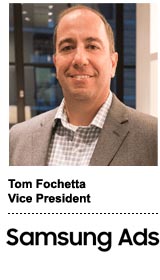
Why would a consumer device giant like Samsung want to get into media sales?
It seems implausible and yet that’s what happened, beginning in 2016 when the company quietly bought a Canadian demand-side platform and ad server called AdGear to build its own stack.
It makes perfect sense to Tom Fochetta, VP of Samsung’s media organization, Samsung Ads.
“We deliver products that enhance people’s everyday lives,” he said, arguing that Samsung Ads is an extension of that commitment.
Samsung Ads is an audience-based platform that reaches consumers across smart TVs and mobile, powered by Samsung’s first-party TV data. That data, Fochetta said, can only be used on a Samsung Ads campaign – it’s not licensed or sold elsewhere.
And that unique first-party data is one of the three major selling points when clients inquire why they should use Samsung Ads. The other two – Samsung’s proprietary ad tech and its scale of 30 million smart TVs – are also important.
“The average home has another six or seven devices,” Fochetta said. “Multiply that by those 30 million smart TVs and our device capabilities are 200 million devices. So that’s the value proposition.”
AdExchanger spoke with Fochetta – whose resume includes long stints at Amazon and Google.
AdExchanger: Why own the actual ad tech?
TOM FOCHETTA: It offers the benefit of managing the environment better, controlling data and the data flows. And, ultimately, your clients and agencies need to trust that you can execute properly. If you outsource something that’s important to your ad business, there’s risk you’ll lose control.
How has Samsung Ads evolved?
When I got here, we started with native ad units on our 30 million smart TVs. We were able to deliver a great advertising environment for tune-in.
So it was natural that we built this platform where we use an insights-driven approach to drive tune-in. We realized that through our own DSP we can now reach users out on the web and in a mobile environment when they’re ingesting mobile content.
Now we’re taking a broader view and looking at this holistic audience, and we’re beyond entertainment, accessing the automotive space, telco, gaming.
What do you do with automotive and telco?
We work with a lot of the major automotive brands. Think about connecting video ad exposure and tying in location-based measurement to determine a dealership visit.
Telco was a category that came out of nowhere. We use ACR [automatic content recognition] to find audiences who are missing their TV commercials. With one [telco client], we determined that only 9% of their target audience was being reached through linear ads. My team helped add incremental reach of over 64% of their target audience.
Did you make any changes to AdGear, or did you just acquire it and integrate it into your process?
I’m not an engineer, but there’s always something being tinkered with. It’s constantly evolving. We’re investing in the ad tech stack and the platform so we can deliver these great experiences on different devices.
When I use Samsung Ads powered by Samsung’s first-party data, what exactly am I getting?
ACR, or automatic content recognition. It’s first-party data that recognizes content on smart TVs. For example, TV shows, linear ads and movies. That data informs our audiences and how we build our products and services at Samsung.
Can marketers bring their own first-party data?
Ad tech is something you’re constantly building based on client needs. That’s more of a future-forward thing.
You have a few data partners on your site. Do you have your own data management platform?
The great thing and bad thing about this industry is there’s a ton of data. It’s difficult to manage. We have opportunity to work with third parties, but what I’m most excited about is our own proprietary first-party data. All that other data has been in the marketplace for a long time now.
Can you do dynamic ad insertion?
Everything I do is dynamic ad insertion if you think about it. You build the operating system, the ad tech, the platform, and you look at the right inventory sources to deliver those ads. So linear, OTT, CTV, digital video. All of these inventory sources are available if you can build a great proprietary ad tech stack, which we’ve done.
Samsung doesn’t own the content. How do you manage ad sales given all the other stakeholders?
It’s a complex ecosystem. It can be frustrating at times, but that’s what makes it exciting.
Samsung has a lot of devices for the internet of things. Is that informing what you do in Samsung Ads as well?
We’re not working with smart fridges just yet. That portion of what we call HA, or home appliance, is still evolving and emerging. And you need scale to build a great business. The tech will continue to emerge. I have young kids and I see how they want to interact with devices. They’d be more than happy for me to bring home a connected fridge. But not yet.
Interview has been edited and condensed.
Kelly Liyakasa contributed.
This post was syndicated from Ad Exchanger.

More Stories
Daily Wire Welcomes Perplexity to Advertise on The Ben Shapiro Show
Here’s the Roundup for the Week Ending March 7
Aflac’s Dan Amos Reveals How He’s Successfully Held Onto the CEO’s Job for 35 Years